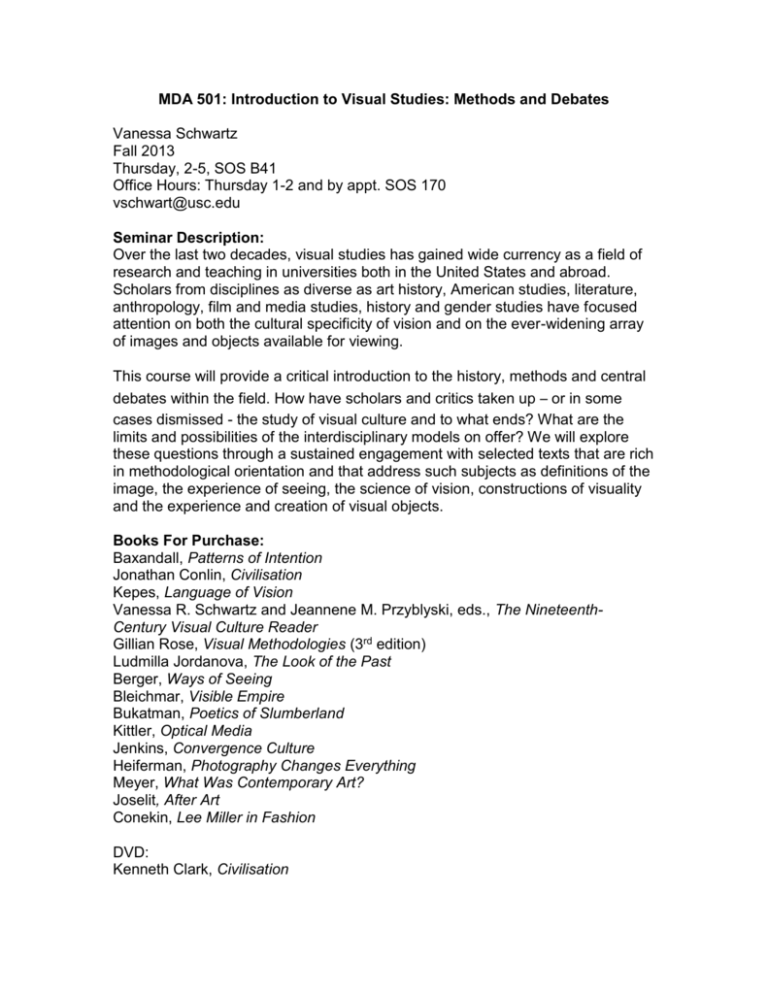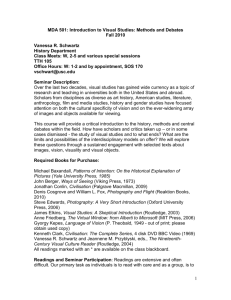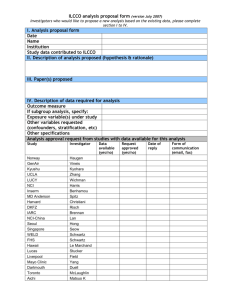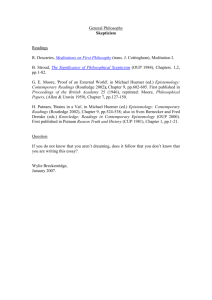MDA 501: Introduction to Visual Studies: Methods and Debates
advertisement

MDA 501: Introduction to Visual Studies: Methods and Debates Vanessa Schwartz Fall 2013 Thursday, 2-5, SOS B41 Office Hours: Thursday 1-2 and by appt. SOS 170 vschwart@usc.edu Seminar Description: Over the last two decades, visual studies has gained wide currency as a field of research and teaching in universities both in the United States and abroad. Scholars from disciplines as diverse as art history, American studies, literature, anthropology, film and media studies, history and gender studies have focused attention on both the cultural specificity of vision and on the ever-widening array of images and objects available for viewing. This course will provide a critical introduction to the history, methods and central debates within the field. How have scholars and critics taken up – or in some cases dismissed - the study of visual culture and to what ends? What are the limits and possibilities of the interdisciplinary models on offer? We will explore these questions through a sustained engagement with selected texts that are rich in methodological orientation and that address such subjects as definitions of the image, the experience of seeing, the science of vision, constructions of visuality and the experience and creation of visual objects. Books For Purchase: Baxandall, Patterns of Intention Jonathan Conlin, Civilisation Kepes, Language of Vision Vanessa R. Schwartz and Jeannene M. Przyblyski, eds., The NineteenthCentury Visual Culture Reader Gillian Rose, Visual Methodologies (3rd edition) Ludmilla Jordanova, The Look of the Past Berger, Ways of Seeing Bleichmar, Visible Empire Bukatman, Poetics of Slumberland Kittler, Optical Media Jenkins, Convergence Culture Heiferman, Photography Changes Everything Meyer, What Was Contemporary Art? Joselit, After Art Conekin, Lee Miller in Fashion DVD: Kenneth Clark, Civilisation Readings and Seminar Participation: Readings are extensive. Our primary task as individuals is to read with care. As a group, our goal is to engage in a discussion that helps illuminate the readings. Seminar participation will be considered an essential component of the class. Expectations and Requirements: Students are expected to complete all required reading prior to seminar meetings and to discuss the texts and critical issues at hand during each session. Each student must also post a “response” to the week’s readings on the class electronic blackboard by no later than 5 am Thursday morning, although posts earlier are welcomed. Students are also expected to read each other’s responses before class and thus we may need to adjust the deadline for submission based on the needs of the group. Students may also use the blackboard to respond to each other’s responses if they choose. A response can be a critical summary of the readings, a series of questions, complaints, rants. The idea behind them is to ask each student to take some time reflecting on the week’s readings and share those thoughts with the class. Special Lectures: As part of this seminar you are expected to attend at least two special events and preferably all. September 12, 5:00-7:00: Victor Navasky, author of The Art of Controversy, in conversation with Jon Wiener, UC, Irvine. Doheny Intellectual Commons. September 27/28: Ephemerality and Durability EMSI Conference, The Huntington. October 3, 12:30-2:00: Scott Bukatman, Stanford: "The Rise and Fall of Cartoon Physics," SOS 250. October 17, 12:30-2:00: Becky Conekin, Yale: "Lee Miller in Fashion," SOS 250. October 19: VSGC CV and Grant-Writing Workshop, USC FINAL PROJECT: You must listen to at least two podcasts a week from the BBC Series, “A History of the World in 100 Objects.” In addition, please screen Kenneth Clark’s Civilisation series by the 12th week of classes. The final exercise in this class is to take any object or lesson about the visual you want to prepare (perhaps related to your own research) and make a short film or powerpoint or other sort of slideshow of this “lesson” about the object or problem. In other words, your final project is to “visualize” a lesson about the visual past. In addition, you are to write a 10-12 page paper, “Visualizing Knowledge” which reflects on the methods and approaches you used in making your project. This paper will consider the different “theories and methods” and definitions of Visual Studies. Students in this context are asked to reflect upon whether Visual Studies represents a separate discipline (and thus could be a field in which one could get a Ph.D.) and/or to consider what it means that Visual Studies is considered an interdisciplinary field. In preparation for this, please also read: ***Vanessa R. Schwartz, “Film and History,” in James Donald and Michael Renov, eds., The Sage Handbook of Film Studies (Sage, 2008), pp. 199-215 and ***Mitchell, “Showing Seeing” in the Journal of Visual Culture. Part I: Definitions Week One: August 29: Defining a Field and a Crisis Complete for Class: Readings and Posting Post an image(s) on the blackboard for class and explain (in writing) “why the image” and “Why Visual Studies” for you? And consider this in response to the week’s readings. Due by 5 am, August 28th • Read for First Class: ***Carlo Ginzburg, etc., “Inter/Disciplinarity,” Art Bulletin 77:4 (December 1995), pp. 534-552. • “The Visual Culture Questionnaire” October 77 (Summer 1996): 25-70. • “The Heart of the Matter” Humanities Commission Report: http://www.humanitiescommission.org/_pdf/hss_report.pdf Week Two: September 5: Defining Visual Studies: RESCHEDULE for Rosh Hashona • *** Horst Bredekamp, “A Neglected Tradition? Art History as Bildwissenschaft,” Critical Inquiry 29 (Spring 2003), pp. 418-428. • *** W. J. T. Mitchell, Introduction and “The Pictorial Turn,” Picture Theory (The University of Chicago Press, 1994), pp.1-34. • Krios, “What are Images and What are they For?” online at http://www.kunst-als-wissenschaft.de/multimedia/KroisEn.pdf • Vanessa R. Schwartz and Jeannene M. Przyblyski, eds., The NineteenthCentury Visual Culture Reader (Routledge, 2004): Schwartz and Przybliski, “Visual Culture’s New History: Twenty-First Century Interdisciplinarity and Its Nineteenth-Century Objects,” pp. 3-14; and • Cohen and Higonnet, “Complex Culture,” pp. 15-26. Gillian Rose, Visual Methodologies, pp. 1-50 and 105-148. Week Three: September 12: Materialism and The Image: Benjamin’s Marxism EVENT: Victor Navasky at 5:00: In conversation with Jon Wiener • Vanessa R. Schwartz and Jeannene M. Przyblyski, eds., The NineteenthCentury Visual Culture Reader (Routledge, 2004): Benjamin, “The Work of Art in the Age of Mechanical Reproduction,” pp. 63-70; and Marx, “Commodities and Money,” pp. 42-47. • • • ***(read online)***Vanessa Schwartz, “Walter Benjamin for Historians,” in The American Historical Review 106:5 (December 2001): http://www.historycooperative.org/journals/ahr/106.5/ah0501001721.html John Berger, Ways of Seeing (Viking Press, 1973). Journal of Visual Culture, August 2012, “Ways of Seeing” 40th Anniversary Issue. Watch at least one episode of “Ways of Seeing” Week Four: September 19: Context and The Social Eye • Martin Jay, from Downcast Eyes, pp.1-147. • Michael Baxandall, Patterns of Intention: On the Historical Explanation of Pictures (Yale University Press, 1985), pp. 1-104. • • • *** Svetlana Alpers, “Is Art History?” Daedalus 106:3 (Summer, 1977), 113. The Nineteenth-Century Visual Culture Reader (Routledge, 2004): Wilson, pp. 26-33 and Genealogies, pp.35-63. Gillian Rose, pp. 202-221. Week Five: September 26: The Sensory Horizon: Food, Durability and Ephemerality: Special Guests: Jessica Keating, USC EMSI-VSRI postdoc and Melissa Calaresu, Cambridge Articles by Keating and Calaresu, to be posted David M. Kaplan, “Introduction,” in David M. Kaplan ed., The Philosophy of Food (Berkeley: University of California Press, 2012): 1-23. Carolyn Korsmeyer, “The Hierarchy of the Senses,” in Making Sense of Taste: Food and Philosophy (Ithaca: Cornell University Press, 1999): 1137. Pierre Bourdieu, “The Homology between the Space,” in Distinction: A Social Critique of the Judgment of Taste, trans. Richard Nice (Cambridge Mass.: Harvard University Press, 1984): 175-208. Sheila McTighe, “Foods and the Body in Italian Genre Paintings, about 1580: Campi, Passarotti, Carracci” The Art Bulletin, Vol. 86, No. 2 (2004): 301-323. Brian Cowan, “Food Representations in Early Modern Europe: Powerful Appetites,” in A Cultural History of Food, Fabio Parasecoli and Peter Scholliers, general editors vol. 4, The Early Modern Age, Beat Kümin, ed., (Oxford: Berg, 2012): 165-183. Emsi/VSRI Conference at the Huntington, 27-28 September PART II: The Question of Media Week 6: October 3: Media Specificity, Special Guest, Scott Bukatman • Bukatman, Poetics of Slumberland • Boxer, Krazy Kat Criticism: http://lareviewofbooks.org/article.php?id=639&fulltext=1 • Interview with Philip Nel, http://westfieldcomics.com/blog/interviews-andcolumns/interview-philip-nel-eric-reynolds-on-crockett-johnsons-barnabyfrom-fantagraphics/ Week 7: October 10: Guest, John Blakinger, doctoral candidate, Stanford It’s All in Your Mind: Kepes and the Origins of Visual Studies Kepes, Language of Vision ***Goodyear, “Gyorgy Kepes, Billy Kl¨uver, and American Art of the 1960s: Defining Attitudes Toward Science and Technology,” Science in Context 17 (2004): 611-635. Week 8: October 17: Fashion Meets Photography Guest: Becky Conekin, Yale University Conekin, Lee Miller In Fashion Week 9: October 24: Photography as History Guest: Matt Amato, History, USC Heiferman, Photography Changes Everything Chapter from Alan Trachtenberg and selection from Amato dissertation Week 10: October 31: Intermediality: Special Guest: Henry Jenkins Kittler, Optical Media Jenkins, Convergence Culture PART III: CONTEXTUALIZATION IS ALL Week 11: November 7: Seeing The Past Jordanova, The Look of the Past Conlin, Civilisation Discussion of Clark Series Week 12: November 14: Getty Visit with Daniela Bleichmar Read: Visible Empire Vanessa R. Schwartz and Jeannene M. Przyblyski, eds., The NineteenthCentury Visual Culture Reader (Routledge, 2004): Ames, “From the Exotic to the Everyday: The Ethnographic Exhibition in Germany,” pp. 313-326; Bennett, “The Exhibitionary Complex,” pp. 117-130. Week 13: November 21: The Global Contemporary Art and Visual Culture Meyer, What Was Contemporary Art? Joselit, After Art **Lawrence Alloway, “Art and the Communications Network,” Canadian Art, no.100, January 1966. **Martin, “Art World, Network and Other Alloway Keywords” http://www.tate.org.uk/research/publications/tate-papers/art-world-network-andother-alloway-keywords Week 14: Thanksgiving Week 15: Final Visual Presentations: To be re-scheduled 10 page paper due electronically by June 10 at 5pm.







